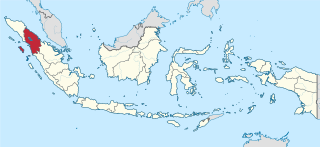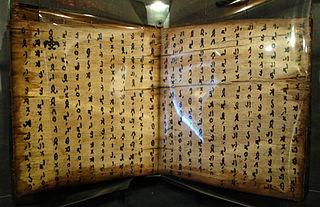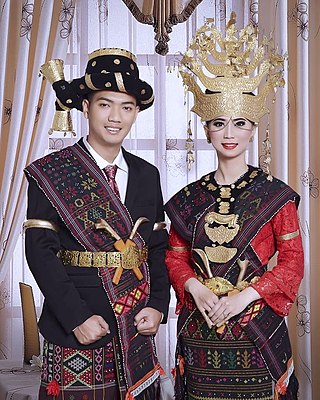The Batak script is a writing system used to write the Austronesian Batak languages spoken by several million people on the Indonesian island of Sumatra. The script may be derived from the Kawi and Pallava script, ultimately derived from the Brahmi script of India, or from the hypothetical Proto-Sumatran script influenced by Pallava.

North Sumatra, also called North Sumatra Province, is a province of Indonesia located in the northern part of the island of Sumatra, just south of Aceh. Its capital and largest city is Medan on the east coast of the island. It is bordered by Aceh on the northwest and Riau and West Sumatra on the southeast, by coastlines located on the Indian Ocean to the west, and by the Strait of Malacca to the east.

Batak is a collective term used to identify a number of closely related Austronesian ethnic groups predominantly found in North Sumatra, Indonesia, who speak Batak languages. The term is used to include the Karo, Pakpak, Simalungun, Toba, Angkola, Mandailing and related ethnic groups with distinct languages and traditional customs (adat).

The Huria Kristen Batak Protestan is an Evangelical Lutheran church among the Batak people, generally the Toba Batak in Indonesia. This church uses an Ecumenical worship style influenced by the Dutch Reformed Church due to the influence of Dutch colonialism in Indonesia, as well as the legacy obtained from the Rhenish Missionary Society when the church was founded. With a membership of 4,133,000, it is one of the largest Protestant churches in Indonesia and Southeast Asia. Its present leader is Ephorus (bishop) Robinson Butarbutar.

The Karo people are a people of the Tanah Karo in North Sumatra, Indonesia. The Karo lands consist of Karo Regency, plus neighboring areas in East Aceh Regency, Langkat Regency, Dairi Regency, Simalungun Regency, and Deli Serdang Regency. In addition, the cities of Binjai and Medan, both bordered by Deli Serdang Regency, contain significant Karo populations, particularly in the Padang Bulan area of Medan. The town of Sibolangit, Deli Serdang Regency in the foothills of the road from Medan to Berastagi is also a significant Karo town.

The Mandailing people are an ethnic group in Sumatra, Indonesia that is commonly associated with the Batak people. They are found mainly in the northern section of the island of Sumatra in Indonesia. They came under the influence of the Kaum Padri who ruled the Minangkabau of Tanah Datar. As a result, the Mandailing were influenced by Muslim culture and converted to Islam. There are also a group of Mandailing in Malaysia, especially in the states of Selangor and Perak. They are closely related to the Angkola and Toba.

Toba Batak is an Austronesian language spoken in North Sumatra province in Indonesia. It is part of a group of languages called Batak. There are approximately 1,610,000 Toba Batak speakers, living to the east, west and south of Lake Toba. Historically it was written using the Batak script, but the Latin script is now used for most writing.
Debuccalization or deoralization is a sound change or alternation in which an oral consonant loses its original place of articulation and moves it to the glottis. The pronunciation of a consonant as is sometimes called aspiration, but in phonetics, aspiration is the burst of air accompanying a stop. The word comes from Latin bucca, meaning "cheek" or "mouth".

Karo, referred to in Indonesia as Bahasa Karo, is an Austronesian language that is spoken by the Karo people of Indonesia. It is used by around 600,000 people in North Sumatra. It is mainly spoken in Karo Regency, southern parts of Deli Serdang Regency and northern parts of Dairi Regency, North Sumatra, Indonesia. It was historically written using the Batak alphabet which is descended from the Brahmi script of ancient India by way of the Pallava and Old Kawi scripts, but nowadays only a tiny number of Karo can write or understand the script, and instead the Latin script is used.

North Padang Lawas is a landlocked regency in the North Sumatra province of Indonesia. It has an area of 3,918.05 km2, and had a population of 223,049 at the 2010 census and 260,720 at the 2020 census; the official estimate as of mid-2023 was 275,448. North Padang Lawas Regency was created on 17 July 2007 from the eastern parts of the South Tapanuli Regency. Its administrative seat is the town of Gunung Tua.

Simalungun Regency is a regency in North Sumatra Province of Indonesia. Its seat was formerly at Pematangsiantar, but this city was under Law No.15 of 10 March 1986 was separated from the Regency and made into an independent city (kota), although it remains geographically surrounded by the regency, whose new administrative seat is at Raya, while the regency's two most populous districts are Bandar and Siantar. The regency now covers an area of 4,372.5 square kilometres, and at the 2010 census it had a population of 817,720; at the 2020 Census this had risen to 990,246, of whom 497,314 were males and 492,932 were females; the official estimate as at mid 2023 was 1,035,920 - comprising 521,262 males and 514,658 females.

Mandailing Batak or Mandailing is an Austronesian language spoken in Sumatra, the northern island of Indonesia. It is spoken mainly in Mandailing Natal Regency, North Padang Lawas Regency, Padang Lawas Regency, and eastern parts of Labuhan Batu Regency, North Labuhan Batu Regency, South Labuhan Batu Regency and northwestern parts of Riau Province. It is written using the Latin script but historically used Batak script.

The Simalungun people are an ethnic group in North Sumatra, considered one of the Batak peoples. Simalungun people live mostly in Simalungun Regency and the surrounding areas, including the city of Pematang Siantar, an autonomous city, but previously part of Simalungun Regency.

The Toba Batak people are the largest ethnic group of the Batak peoples of North Sumatra, Indonesia. The general term ‘Batak’ is sometimes used to refer to the Batak Toba people, for one thing because the Toba people are the largest sub-group of the Batak ethnicity, for another because they tend to self-identify as merely Batak instead of ‘Toba’ or ‘Batak Toba’, contrary to the habit of the Karo, Mandailing, Simalungun, Pakpak communities who commonly self-identify with their respective sub-groups.

Batak architecture refers to the related architectural traditions and designs of the various Batak peoples of North Sumatra, Indonesia. Six groups of Batak speak separate but related languages: the Angkola, the Mandailing to the south, the Toba, to the north the Pakpak/Dairi, the Simalungun, and the Karo. While the groups are now Muslim or Christian, elements of the ancient Batak religion remain, particularly amongst the Karo.

Batak cuisine is the cuisine and cooking traditions of Batak ethnic groups, predominantly found in Northern Sumatra region, Indonesia. Batak cuisine is part of Indonesian cuisine, and compared to other Sumatran cuisine traditions, it is more indigenously preserved. One characteristic of Batak cuisine is its preference to andaliman as the main spice. That is why andaliman in Indonesia sometimes dubbed as "Batak pepper".

The Angkola people are part of the Batak ethnic group from North Sumatra who live in the South Tapanuli regency. The Angkola language is similar to Mandailing language also with Toba language, but it is sociolinguistically distinct.

Singkil people are an ethnic group of people found in Aceh Singkil Regency and Subulussalam, Aceh province, Indonesia.

The Alas people is an indigenous ethnic group from Southeast Aceh Regency, Aceh, Sumatra, Indonesia. The Alas are found in the Gunung Leuser, Ketambe, and Alas River areas.

















